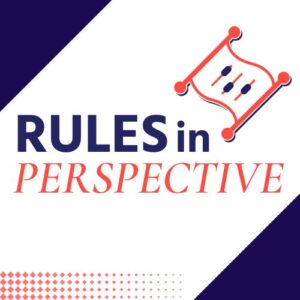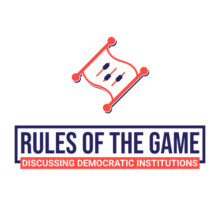
On Episode 39
Fixing the House with Proportional Representation
Rules in Perspective is a new segment on Rules of the Game – discussing democratic institutions. In this new segment I review and comment on my own podcast episodes.
In this episode of Rules in Perspective I review the podcast episode 39 on Fixing the House with Proportional Representation with Lee Drutman.
My three takeaways:
- John Adams’ Nightmare
- Electoral reform is an uphill battle, but worth it.
- Electoral reform from below.
Listen to episode 39 and find the show notes here.
Book: Breaking the Two-Party Doom-Loop by Lee Drutman
It would be great to hear your opinion and feedback on this new format. If you want to send me an email, you can reach me at rulesofthegame.ddi@gmail.com. If you find my discussions interesting and you’d like to support my work, consider buying me a coffee at https://www.buymeacoffee.com/rulesofthegame
Related Episodes:
The Dream of a Truly American Democracy by Stephan Kyburz (Ep. 1)
Proportional Representation in America? with Jack Santucci (Ep. 12):
New Zealand’s Electoral Reform with Jack Nagel (Ep. 30):
Full Transcript:
My name is Stephan Kyburz, and this is the fourth edition of Rules in Perspective. In the next few minutes, I will provide my three take-aways from episode 39 on fixing the U.S. House of Representatives with proportional representation, a discussion I had with Lee Drutman
Rules in Perspective is a new segment on the Rules of the Game channel, where I reflect and comment on my own podcast episodes. You can find Rules in Perspective both as a video on my Youtube channel and as a bonus episode on my podcast Rules of the Game. It is important to mention that these are my personal comments and do not necessarily reflect the views of my guests or the organizations they work for.
I read the book “Breaking the Two-Party Doom-Loop” very soon after it was published, I actually put myself on the waiting list before publication. It was the type of book that I was hoping to find. It was also during that time that I started thinking more about democratic institutions and how so many countries fall way short of decent democracy. Once you’ve seen how wrong many governments work, you can’t unsee it. The book inspired me the reflect on Switzerland’s institutions, and on many other countries’ institutions. This thought process finally led me to start the podcast Rules of the Game. At that time I was in academia, and suddenly I thought that I could write many more papers, but it wouldn’t change much about how the public understands democracy. I felt the urge to contribute to the public discussion, not the academic discussion.
Long story short, having Lee Drutman as a guest on the podcast was like closing the circle of my own search for.
Point 1: John Adams’ Nightmare
In the first point, I want to read a quote by John Adams about the House of Representatives, from the book “Thoughts on Government”, published already in 1776, that I found in a recently published report on proportional representation co-authored by Grant Tudor and Beau Tremitiere. The report is called “Towards Proportional Representation for the U.S. House – Amending the Uniform Congressional District Act”, explains the deficiencies of winner-take-all elections and what reforms are necessary to introduce proportional representation to the U.S. House. And I link to the report in the show notes. But here is the quote at the beginning of the report:
“The principal difficulty lies, and the greatest care should be employed in constituting this representative assembly. It should be in miniature an exact portrait of the people at large. It should think, feel, reason and act like them. That it may be the interest of the assembly to do strict justice at all times, it should be an equal representation, or, in other words, equal interests among the people should have equal interests in it. Great care should be taken to effect this, and to prevent unfair, partial and corrupt elections.”–
One of the biggest worries of the framers was that powerful factions would control the political system and society as a whole. Yet, this is exactly what we have today. That’s why he proposed a system of proportional representation in words. To me a balanced and fair representation of all political interests in society is the foundation of a functioning democracy.
The USA today, both at the national and local level, are controlled by two very powerful factions that do not represent the people well. The two parties are simply too powerful, which opens the doors to lobbying and corruption. Legislation is written to appease special interests. The system prevents third parties from entering the political arena that could challenge that power. The situation today was probably John Adam’s nightmare.
Point 2: Electoral reform is about political power. It’s an uphill battle, but worth it.
My second point is on the difficulty of bringing about electoral reform. Since electoral reform is about re-balancing political power, re-allocating political power to reflect the entire citizens’ political spectrum, those that are in power will fight any reform efforts. My prediction is that the more momentum the electoral reform movement will gain, the stronger the backlash by the two parties will be. It’s an uphill battle!
I’d expect lots of money being donated by the establishment to prevent electoral reform. Campaigns that claim that the current system works just fine, claiming that the USA always had the first-past-the-post system and everything is fine.
There could arise certain situations where one of the parties may have an incentive to adopt a different electoral system to insulate their power and protect the democracy. For instance, a situation when either the Democrats or Republicans would be worried to lose power in Washington for good. Therefore a party could choose electoral reform to at least not lose all the power to the other party. That’s what Jack Santucci calls a coalition-insulating reform, described in his book “More parties or no parties”.
I expect electoral reform to become one of the hardest struggles of American democracy in the 21st century. And I am sure people in America will hear lots of voices, lots of media outlets, lots of arguments against proportional representation.
Point 3: Electoral reform from below
My third point is on the possibilities of electoral reform from below. By that I mean that states, counties, and cities of the American federation successfully perform different types of electoral reforms and show what systems work better, and what systems work worse.
To me the most promising avenue for electoral reform is (in quotes) experimenting with different electoral systems at the state and city level. For instance, if some states would somehow adopt proportional representation for their State Assembly elections, it would exemplify how electoral reform could allow other parties to compete and win seats in state parliaments. In some states that may happen through ballot initiatives. Successful reforms at the state level may make it more likely that enough political pressure can be built up also at the federal level.
That’s it for the fourth edition of Rules in Perspective. Thanks for taking the time, I hope you enjoyed it. Feel free to send feedback to rulesofthegame.ddi@gmail.com
I have published several episodes on electoral reform and proportional representation on my podcast that I can recommend to anyone interested in this topic.
In my first episode ever I talked about the “Dream of a Truly American Democracy”, where I explain how the switch to proportional representation for the House of Representatives in Switzerland in 1919 completely changed the political game and created a much more balanced legislature.
In episode 12, I discuss electoral reform and the possibilities for proportional representation in the US with Jack Santucci based on his book “More parties or no parties – The Politics of Electoral Reform in America”
With Jack Nagel I discussed the successful electoral reform in New Zealand in episode 30. New Zealand got rid of first-past-the-post winner-take-all elections and introduced a mixed-member proportional system in 1996.
As always, I link to all episodes in the description below.
I appreciate you’ve taken the time to watch Rules in Perspective. See you next time.
